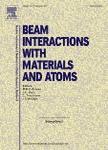版权所有:内蒙古大学图书馆 技术提供:维普资讯• 智图
内蒙古自治区呼和浩特市赛罕区大学西街235号 邮编: 010021

作者机构:Univ Southern Denmark Dept Phys Chem & Pharm DK-5230 Odense M Denmark Joint Inst Nucl Res Flerov Lab Nucl React RU-141980 Dubna Russia Johannes Kepler Univ Linz Dept Expt Phys A-4040 Linz Austria
出 版 物:《NUCLEAR INSTRUMENTS & METHODS IN PHYSICS RESEARCH SECTION B-BEAM INTERACTIONS WITH MATERIALS AND ATOMS》 (物理学研究中的核仪器与方法,B辑:射束与材料及原子的相互作用)
年 卷 期:2019年第460卷
页 面:10-18页
核心收录:
学科分类:08[工学] 0804[工学-仪器科学与技术] 0827[工学-核科学与技术] 0702[理学-物理学]
主 题:Stopping power Reciprocity Transmission measurement Threshold effects PASS code
摘 要:Reciprocity denotes the (approximate) equality of the electronic stopping cross section of element A in element B with the one of element B in element A. Reciprocity is expected in the energy range below similar to 0.1 MeV/u. For ions heavier than protons, most measurements are performed by the transmission technique. In order to minimize nuclear energy loss, only a narrow beam of penetrating ions is allowed to enter the detector. This implies that also the electronic energy loss is underestimated. We have estimated the magnitude of the necessary correction on the basis of the PASS code and its influence on the expected reciprocity and find that reciprocity is not necessarily violated, even if the reported cross sections differ significantly. However, we also find differences between reported stopping cross sections and computed reduced stopping cross sections that we cannot reconcile on the basis of the PASS code. These differences are found to reflect the well-known Z(1) structure, which is not inherent in the present version of PASS.